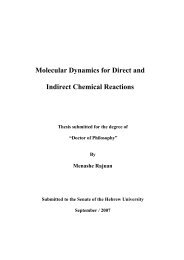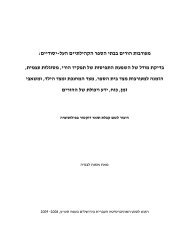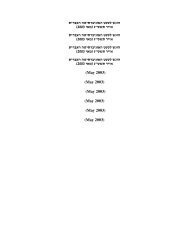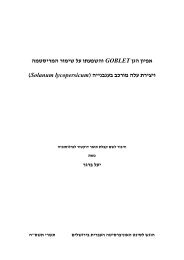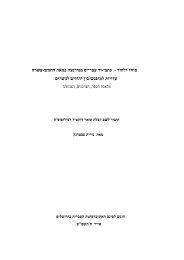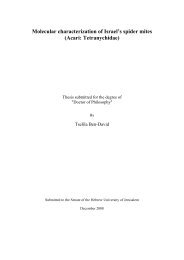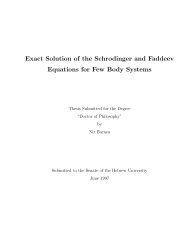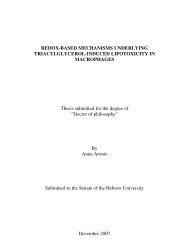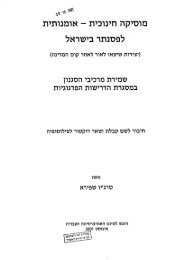Revealing the Mechanism of HSP104 Transcription Initiation in the ...
Revealing the Mechanism of HSP104 Transcription Initiation in the ...
Revealing the Mechanism of HSP104 Transcription Initiation in the ...
Create successful ePaper yourself
Turn your PDF publications into a flip-book with our unique Google optimized e-Paper software.
Overall, <strong>the</strong> results never<strong>the</strong>less show a general correlation between reporter<br />
activity and mRNA levels. Namely, <strong>the</strong> genes deleted <strong>in</strong> 15 stra<strong>in</strong>s out <strong>of</strong> <strong>the</strong> 17<br />
tested, encode prote<strong>in</strong>s that are required for proper <strong>in</strong>duction <strong>of</strong> <strong>the</strong> <strong>HSP104</strong> promoter.<br />
Our results strongly suggest <strong>the</strong> <strong>in</strong>volvement <strong>of</strong> <strong>the</strong> SAGA complex (represented by<br />
<strong>the</strong> spt7∆, gcn5∆ mutants), <strong>the</strong> SRB/MED coactivator complex (represented by <strong>the</strong><br />
srb2∆, srb5∆, srb8∆, srb9∆, srb10∆, and med1∆ mutants) as well as <strong>the</strong> SWI/SNF<br />
chromat<strong>in</strong> remodel<strong>in</strong>g complex (snf6∆ mutant) <strong>in</strong> mediat<strong>in</strong>g <strong>HSP104</strong> transcription<br />
<strong>in</strong>itiation (Table 4). In addition, we also measured promoter activity and mRNA<br />
levels <strong>of</strong> <strong>HSP104</strong> <strong>in</strong> rpb4∆ cells and observed that <strong>HSP104</strong> is barely, if at all, <strong>in</strong>duced<br />
<strong>in</strong> this stra<strong>in</strong> <strong>in</strong> response to heat shock. Rpb4 is a RNA PolII subunit which is not<br />
essential for growth under optimal growth conditions, but essential under stress and is<br />
important for <strong>the</strong> activation <strong>of</strong> PolII under heat shock conditions (23, 24, 89, 97, 98).<br />
As <strong>the</strong> components identified are part <strong>of</strong> <strong>the</strong> basal mach<strong>in</strong>ery we wondered whe<strong>the</strong>r<br />
<strong>the</strong> defective <strong>in</strong>duction <strong>of</strong> <strong>HSP104</strong> <strong>in</strong> <strong>the</strong>se mutants is specific to <strong>HSP104</strong>, or whe<strong>the</strong>r<br />
<strong>the</strong> mutants demonstrate a general abnormality <strong>in</strong> <strong>in</strong>duc<strong>in</strong>g stress genes <strong>in</strong> response to<br />
heat shock. To this end we measured <strong>the</strong> mRNAs <strong>of</strong> HSP26 and SSA3, two HSP<br />
encod<strong>in</strong>g genes known to be <strong>in</strong>duced <strong>in</strong> response to heat shock. As shown <strong>in</strong> Figure<br />
15, most <strong>of</strong> <strong>the</strong> mutants tested <strong>in</strong>duced HSP26 and SSA3 normally, suggest<strong>in</strong>g that <strong>the</strong><br />
failure <strong>of</strong> <strong>the</strong> mutants to properly <strong>in</strong>duce <strong>HSP104</strong> is specific. We did notice however,<br />
that some mutants, like rpb4∆ and snf6∆, seem to have more general defects <strong>in</strong><br />
<strong>in</strong>duc<strong>in</strong>g stress genes. Curiously, SSA3 mRNA levels were spontaneously elevated <strong>in</strong><br />
most mutants.<br />
WT<br />
dst1∆<br />
hst1∆<br />
srb8∆<br />
srb10∆<br />
spt7∆<br />
gcn5∆<br />
srb2∆<br />
HS - + - + - + - + - + - + - + - +<br />
HS<br />
srb5∆<br />
snf6∆<br />
rpb4∆<br />
sas3∆<br />
mft1∆<br />
cdc73∆<br />
med1∆<br />
srb9∆<br />
- + - + - + - + - + - + - + - +<br />
HSP26<br />
HSP26<br />
SSA3<br />
SSA3<br />
Figure 15. Most factors required for proper <strong>in</strong>duction <strong>of</strong> <strong>HSP104</strong> are specific for this gene.<br />
RNA from mutants that demonstrated impaired <strong>HSP104</strong> <strong>in</strong>duction <strong>in</strong> response to heat shock, were used<br />
to measure mRNA levels <strong>of</strong> HSP26 (sample <strong>of</strong> no heat shock and ten m<strong>in</strong>utes heat shock were used)<br />
and SSA3 (sample <strong>of</strong> no heat shock and fifteen m<strong>in</strong>utes heat shock were used).<br />
42



